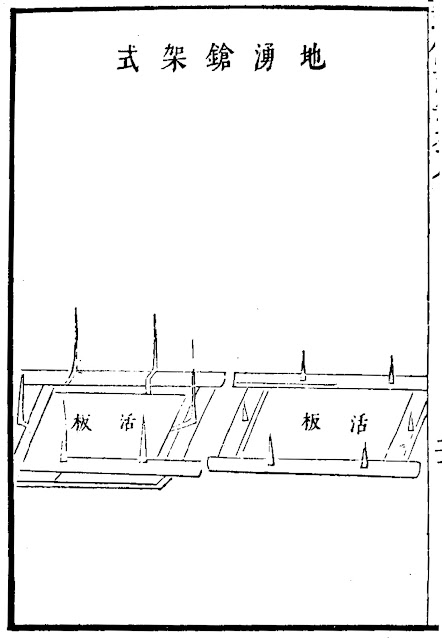UPDATED NOVEMBER 17, 2023
 |
| Sprung trap (left) and unsprung trap (right), from 'Wu Bei Zhi (《武備志》)'. |
Di Yong Qiang (地湧鎗, lit. 'Ground surge spear'), also known as
Di Yong Shen Qiang (地湧神鎗, lit. 'Ground surge divine spear') is a simple yet deadly pressure plate-activated spiked trap. Designed to be easy to use, mass-producible and disposable, Di Yong Qiang consists of a flat, rectangular wooden frame, a wooden plank serving as pressure plate, and up to eight steel spikes connected to the pressure plate with ropes and eye bolts.
Setting up Di Yong Qiang is a simple matter of digging a small pit into the ground before placing a prefabricated Di Yong Qiang on top of the hole. Di Yong Qiang's low cost and ease of use allow large numbers of the spiked traps to be set up in a relatively short amount of time, making it an excellent area-denial weapon.

This is really interesting. It's not clear to me how the weights and pulleys work, or how the pressure plate triggers them. In particular, I would imagine the spears need to emerge quickly and forcefully to impact the target, which would seem hard to manage without a strong spring mechanism. Also, are there any documented use cases?
ReplyDelete@Angus
DeleteAfter re-reading the text I've made some updates to the article. The trap doesn't even use pulley, as simple eye bolt (or similar devices) is suffice. The spikes are made of steel so they serve as weights naturally.
The spikes do NOT jut out suddenly and forcefully like the case with a powerful spring trap. However, since the trap is placed above a pit, anyone stepping on the plate is effectively stepping into a trapping pit, so escaping before the spikes fully jut out is not as easy as you think (though not impossible). Not to mention this trap was used in North China, so it's far more likely that a horse steps on it than a man.
No specific use case comes to mind. The trap was generally used to defend an encampment or laid on routes that Mongol horsemen frequently pass through to ambush them. This level of details tend not to get recorded.